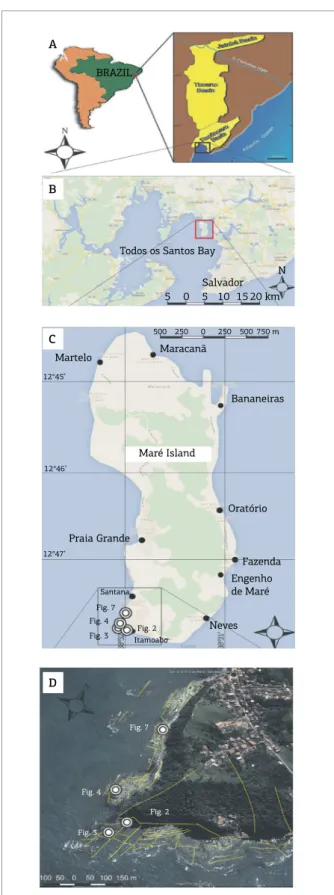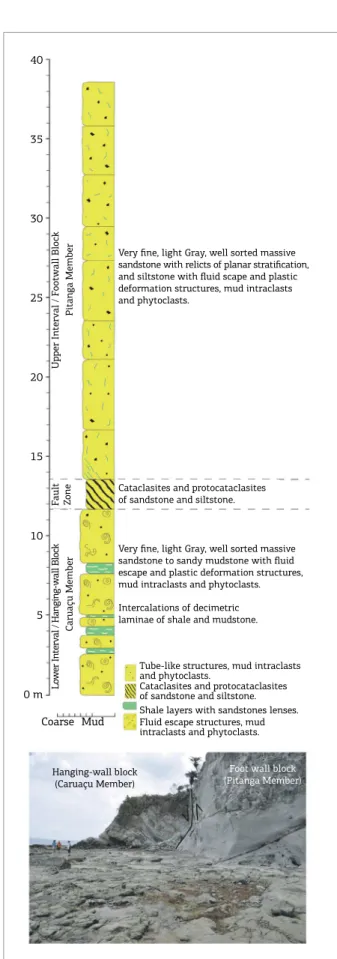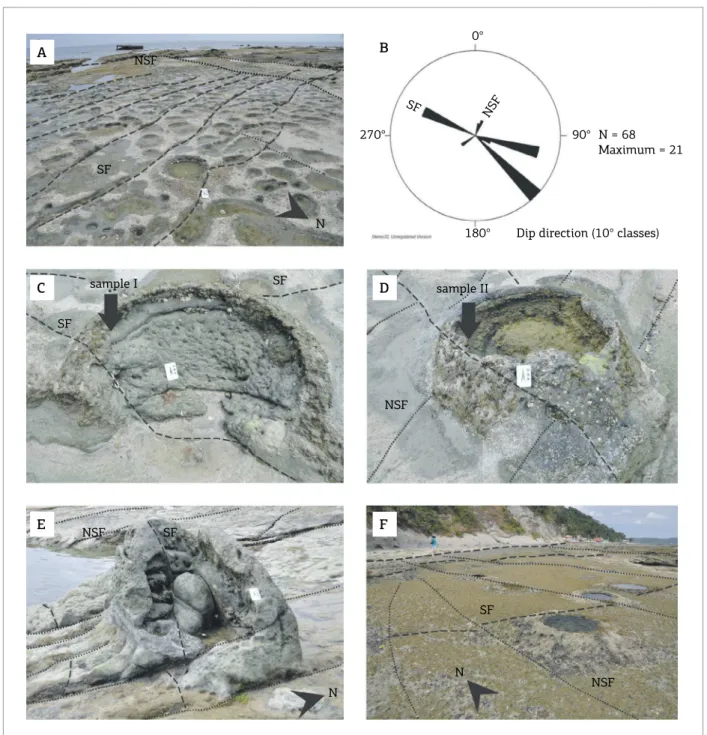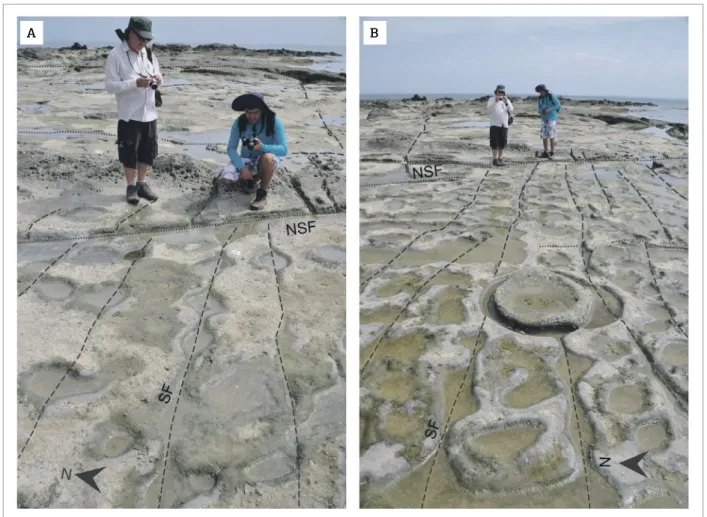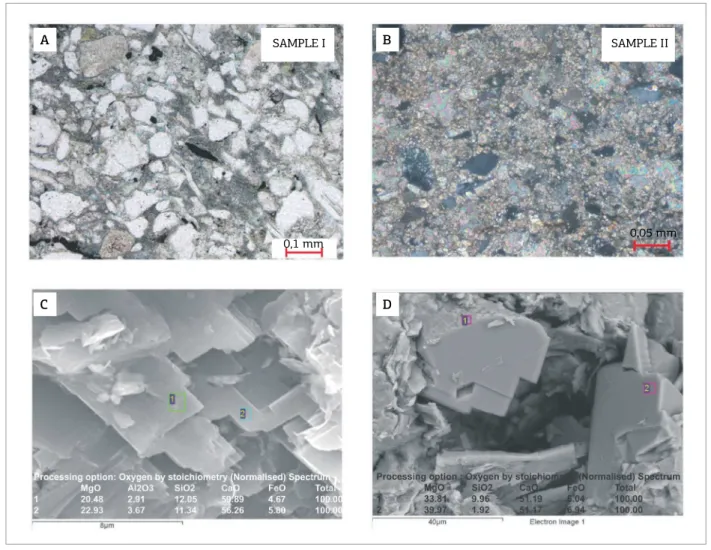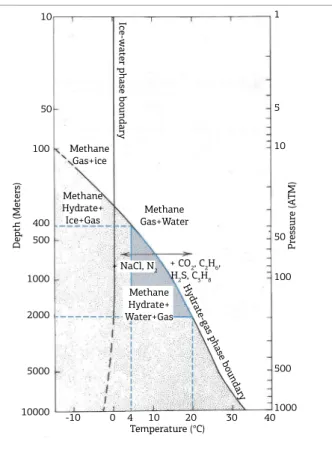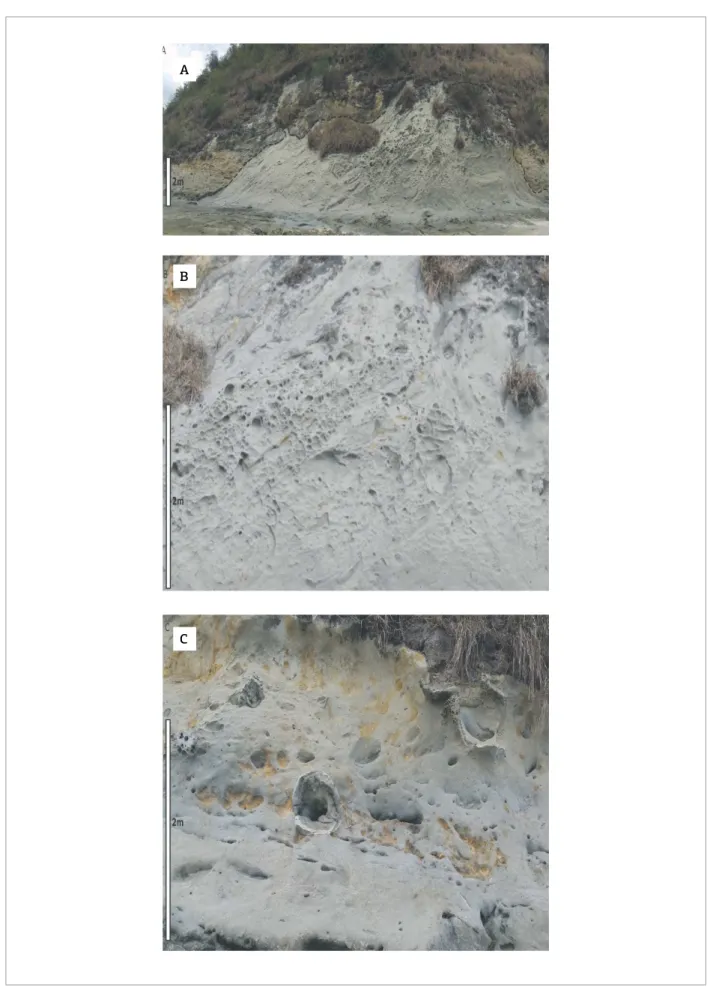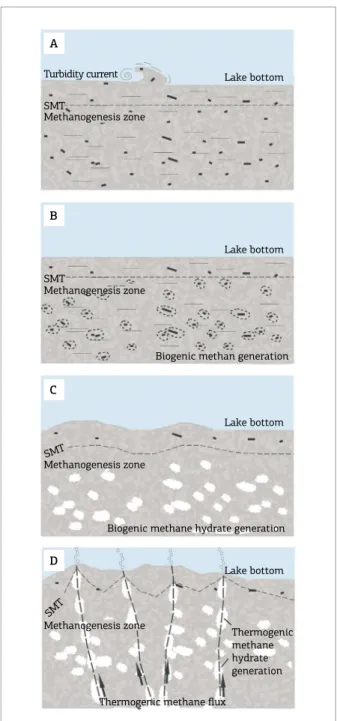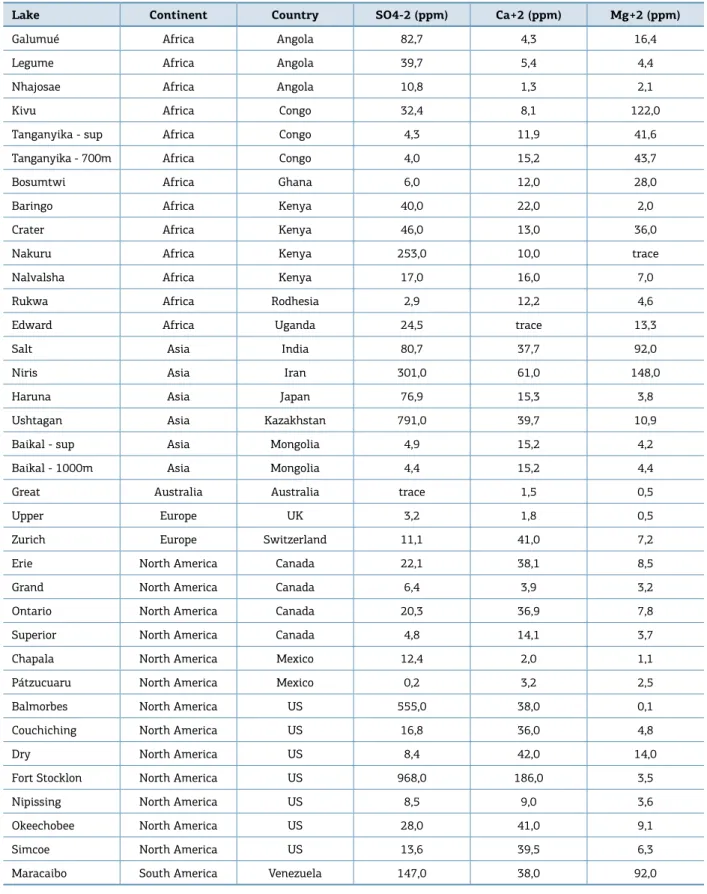1Instituto de Geociências da Universidade Federal Fluminense – UFF, Niterói (RJ), Brazil. E‑mail: afmfreire62@gmail.com
2Petrobras, Unidade de Operação da Bahia – UO‑BA. Salvador (BA), Brazil. E‑mails: cmml@petrobras.com.br, fmo@petrobras.com.br, milhomem@petrobras.com.
br, marciog@petrobras.com.br
3Petrobras Research and Development Center – CENPES, Rio de Janeiro (RJ), Brazil. E‑mail:pietzsch@petrobras.com.br 4Petrobras Exploration and Production – E&P/EXP, Rio de Janeiro (RJ), Brazil. E‑mail: rdavila@petrobras.com.br
*Corresponding author.
Manuscript ID: 20160090. Received in: 07/21/2016. Approved in: 01/05/2017. ABSTRACT: Empty elliptical vesicles are observed in outcrops of Barremian very fine clayey sandstone to siltstone lacustrine slurry deposits of the Pitanga Member (Maracangalha Forma‑ tion), exposed in the Maré Island, Southern Recôncavo Basin, Brazil. These sedimentary features have been traditionally in‑ terpreted as water escape structures triggered by the diapirism of the underlying shales of the Candeias Formation. This work proposes that vesicles were generated during massive gas hydrate dissociation as a result of tectonic activity in a paleolake system. Tectonic uplift would have triggered both the reduction of the confining pressure as well as an increase in lake bottom tem‑ perature, resulting in the instability of gas hydrate and causing intense release of both methane — or carbon dioxide (CO2) — and water. On one hand, this proposal has a strong impact on pa‑ leoenvironmental interpretations, giving support to the current hypothesis that rocks related to the Pitanga Member would have been deposited under water columns deep enough for gas hydrate formation and subsequent dissociation. On the other hand, it provides new insights on the genesis of fluid escape structures in sedimentary rocks, both lacustrine and marine, providing a paleobathymetric indicator.
KEYWORDS: Fluidization; Gas hydrates; Maracangalha Forma‑ tion; Pitanga Member; Recôncavo Basin; Vesicles.
RESUMO: Vesículas elípticas ocas são observadas em aloramentos de areni-tos argilosos muito inos e siltiareni-tos lacustrinos do Membro Pitanga da Formação Maracangalha, expostos na Ilha de Maré, sudeste da Bacia do Recôncavo, Es-tado da Bahia, Brasil. Essas rochas foram depositadas em condições subaquo-sas e são consideradas depósitos gravitacionais do tipo slurry. Essubaquo-sas feições têm sido tradicionalmente interpretadas como sendo estruturas de escape de água, resultado da ação do diapismo de folhelhos sotopostos da Formação Candeias. Este trabalho propõe que as vesículas foram geradas durante uma intensa dis-sociação de hidratos de gás em resposta à atividade tectônica existente naquele sistema lacustre. O soerguimento tectônico do fundo do lago teria propiciado a redução da pressão coninante nos poros sedimentares, bem como o aumento de temperatura nas águas de fundo, resultando na instabilidade dos hidratos de gás contidos nas porções rasas dos sedimentos e causando uma violenta libera-ção de metano — ou gás carbônico (CO2) — e água. Se correta, esta proposta tem um grande impacto na interpretação paleoambiental da Bacia do Recôn-cavo, uma vez que corroborará com a hipótese corrente de que as rochas do Membro Pitanga teriam sido depositadas em ambientes profundos, suicientes para a formação de hidratos de gás e a consequente dissociação em período de soerguimento. Por outro lado, permite uma interpretação adicional acerca da gênese de estruturas de escape de luidos em rochas sedimentares, lacustres ou marinhas, servindo como um potencial indicador de paleobatimetria. PALAVRAS‑CHAVE: Bacia do Recôncavo; Fluidização; Formação Maracangalha; Hidratos de gás; Membro Pitanga; Vesículas.
Fluid escape structures as possible indicators
of past gas hydrate dissociation during the
deposition of the Barremian sediments in
the Recôncavo Basin, NE, Brazil
Estruturas de escape de luidos como possíveis indicadoras de
uma paleo‑dissociação de hidratos de gás durante a deposição de
sedimentos do Barremiano na Bacia do Recôncavo, NE, Brasil
Antonio Fernando Menezes Freire1*, Carlson de Matos Maia Leite2,Flávio Miranda de Oliveira2, Márcio Ferreira Guimarães2, Paulo da Silva Milhomem2,
Raphael Pietzsch3, Roberto Salvador Francisco d’Ávila4
INTRODUCTION
Discussions regarding the formation and dissociation of gas hydrates in oceans, seas and permafrost environments are widely described in the literature (Collett, 2002; Freire, 2010; Haacke et al., 2009; Hyndman & Davis, 1992; Matsumoto, 2005; Matsumoto et al., 2009). However, studies concerning fossil gas hydrate formation and dissociation in both marine and lacustrine environments are rare, since the evidences of such processes are not based on direct observations, as those of present day gas hydrate occurrences. he main challenge of this work is to compare features possibly related to past gas hydrate dissociation in the Recôncavo Basin, NE Brazil, which occurred at about 125 and 130 Ma Before Present (BP), with present‑day occurrences. he evidence provided here is not based on the occurrence of gas hydrates them‑ selves, but relies on the observation of structures, suggesting the presence of ancient gas hydrates.
his article proposes a possible alternative interpretation for the origin of decimeter to meter‑sized vesicles observed in outcrops of very ine clayey massive sandstone to silt‑ stone deposits of the Pitanga Member of the Maracangalha Formation, in the Maré Island, Recôncavo Basin (Fig. 1). hese features have been traditionally interpreted as water escape structures, related to a dewatering process caused by the diapirism of the underlying Candeias Formation shales (Barbosa da Silva et al., 2007).
he occurrence of isolated vesicles suggests that intrafor‑ mational captive over‑pressured luids could have expanded the sedimentary primary porosity, but remained trapped due to the high density, plasticity and low permeability of the host ine to very ine clayey sandstone. During shale diapir‑ ism and the related uplift of the lake loor, pressure release and temperature increase would have favored gas hydrate dissociation and the consequent release of both methane and water, leading to the widespread formation of vesi‑ cles. A similar interpretation was provided by Machel et al.
(2014), who related episodic luid low and dolomitization by methane‑bearing pore water of marine parentage in an accretionary prism setting at Barbados, West Indies.
Our data and indings have a strong impact on paleo‑ environmental interpretations, giving support to the assumption that the Pitanga Member sandstones would have been deposited under deep water conditions, suit‑ able for gas hydrate formation. On the other hand, this hypothesis introduces a new perspective for understand‑ ing the development of luid escape structures in sedi‑ mentary rocks, either lacustrine or marine, providing a paleobathymetric indicator. Another contribution of this work is the inference of gas hydrates dissociation processes in Barremian strata. Up to now, the oldest occurrences
Fig. 3
A
B
C
D
BRAZIL
Todos os Santos Bay
Salvador 5 0 5 10 15 20 km
N
12°45’
12°46’
12°47’
500 250 0 250 500 750 m
Martelo Maracanã
Bananeiras
Maré Island
Praia Grande
Oratório
Fazenda
Engenho de Maré
Neves
Santana
Itamoabo Fig. 7
Fig. 4
Fig. 4
Fig. 2
Fig. 3
Fig. 7
Fig. 2
Figure 1. (A) Location map of the Recôncavo Basin; (B) Location map of Todos os Santos Bay and Maré Island (Google Maps); (C) Maré Island and the study area.
Location of igures 2, 3, 4 and 7 is given for reference; (D)
were reported by Haq (1998), in Paleocene rocks, and the ones studied by Jenkyns (2010), based on carbon iso‑ tope data related to Oceanic Anoxic Events (OAE), such as the Early Toarcian OAE, another warm period which occurred ca.183 Ma ago (Hesselbo et al., 2007; Jenkyns, 2003, and references therein).
Gas Hydrates Background
Natural gas hydrates are solids formed from a combina‑ tion of water and one or more hydrocarbon or non‑hydro‑ carbon gases, resembling packed snow or ice. he gas mole‑ cules are trapped within a crystal structure (cage) composed of water molecules, which is the reason why gas hydrates are also known as clathrates (Sloan Jr., 2003).
Gas hydrates are stable only under speciic pressure‑tem‑ perature, gas composition, and salinity of ambient waters. Natural hydrates commonly contain large amounts of meth‑ ane (> 99%) (Sloan Jr., 2003), in which case they are also called methane hydrates. Experimental analyses indicate that 1 m3 of hydrate dissociates at ambient temperature and
pressure to form 164 m3 of natural methane and 0.8 m3 of
water (Kvenvolden, 1993).
he origin of methane in hydrates can be either thermo‑ genic or biogenic, and seeps are quite common in oceanic hydrate provinces, where this gas is usually released to the sea loor by dispersed seepage over large areas, e.g. in pock‑ marks or crater ields (Ginsburg, 1998; Miller et al., 2015), or by more focused escapes along shallow faults (Freire et al., 2011; Mienert & Posewang, 1999; Suess et al., 1999).
Geologic Setting
he Recôncavo Basin is located in Bahia State, NE Brazil, occupying an area of ca. 11,500 km2 (Fig. 1A). he struc‑
tural coniguration of the basin is related to the extensional stresses that prevailed from the Late Jurassic to the Early Cretaceous, leading to the fragmentation of the Gondwana and the opening of the South Atlantic Ocean. he basin is part of an aborted continental rift system and displays a NE‑SW trending hemi‑graben geometry, with the border fault located to the southeast (Fig. 1A – Barbosa da Silva
et al., 2007). Since the 1950’s, oil and gas exploration, and
development activities have raised a solid knowledge about its sedimentary records and the basin evolution, from the pre‑rift to syn‑rift and post‑rift stages (Netto & Oliveira, 1985; Magnavita, 1992; Barbosa da Silva et al., 2007).
The rift phase comprises strata of Early Berriasian (ca. 144 Ma) to Early Aptian ages (ca. 124 Ma – Barbosa da Silva et al., 2007), depicting an initial lacustrine setting, followed by deltaic and luvial‑deltaic deposition as the basin was illed. Basinal shales and deposits related to turbidites and mass gravity lows characterize the early rift lacustrine
strata of both Candeias and Maracangalha formations (Netto & Oliveira, 1985; Magnavita, 1992).
Gravity lows triggered by earthquakes (Raja Gabaglia, 1991) are recorded by turbidite lobes and channel sand‑ stones as well as slurry deposits, defining sequences of sandstones, sandy lutites and siltstones (Caixeta, 1988). he Caruaçu Member of the Maracangalha Formation is primarily composed of stratiied and massive (slurry) turbidite sandstones. he Pitanga Member, on the other hand, is essentially represented by tens to hundreds of meters of thick slurry deposits, and subordinate deformed ine‑grained stratiied sandstones. he deposition of both members was contemporaneous with the propagation of listric faults induced by lutokinesis of lacustrine shales and mudstones of the Candeias and Maracangalha formations (Barbosa da Silva et al., 2007).
he mini‑basins developed in the hanging wall blocks of the listric faults were the preferential sites for the deposi‑ tion of gravity lows. Post‑depositional luidization process would have been driven by the diferential load associated with the amalgamation of sandy deposits in the mini‑ba‑ sins (Scherer, 2007).
METHODS
Rock sampling and outcrop description
Six rock samples were collected in the Maracangalha formation outcrop at Maré Island, from the walls of sev‑ eral vesicles, for mineralogical, chemical and stable isotope characterization. For biochronostratigraphic purposes, using ostracode biozonation, two samples of the Maracangalha formation outcrop, at Maré Island, were collected, cor‑ responding to intervals of millimeter to centimeter thick medium to dark gray shale beds intercalated in the turbid‑ ite section (Fig. 2). For comparison, ostracods of the same biozone were also collected for isotope analysis from cut‑ tings of an oil well, located 77 km away from outcropping vesicles. Dip‑directions of faults and fractures (Fig. 3A) were measured using a Clar compass, and the dataset was displayed in a stereonet diagram for comprehensive presen‑ tation (Fig. 3B).
Thin sections
X-ray diffractometry, carbonate content,
scanner electronic microscope with
energy dispersive spectroscopy stable
carbon and oxygen isotope analyses
Two representative rock samples (I and II – Figs. 3C and 3D), collected from the vesicle walls, were analyzed for mineralogical and chemical determination using X‑ray difractometry (XRD), calcimetry and carbon iso‑ tope analysis. he samples were cleaned of living faunal incrustations (barnacles) and irst examined through scan‑ ner electronic microscope with energy dispersive spec‑ troscopy (SEM‑EDS). he samples were then ground for whole rock XRD. he powdered samples were also used for measuring the carbonate content and perform‑ ing isotope analyses.
For SEM procedures, the fresh irregular surface of each sample was covered with palladium‑gold, using an EMITECH K750X vacuum apparatus. he samples were analyzed by a JEOL JSM6490LV SEM, as images of sec‑ ondary electrons operated in high vacuum at 20 kV and with a work distance of 10 mm. he EDS microanalysis was obtained from an OXFORD INCA, coupled to the SEM. he semi‑quantitative compositional tables include the weight percentage, the atom percentage and the ele‑ ments in the form of oxides — calculated stoichiometri‑ cally —, normalized to 100%.
For the bulk rock XRD analysis, the samples were ground by a McCRONE mill. he powdered samples were pressed, without orientation, in a support con‑ tainer. hese were run on a RIGAKU D/MAX‑2200/PC difractometer, using copper k‑Alfa radiation at 40 kV and 40 mA current ilament, and 2, 0.3 and 0.6 mm slits. he goniometer speed was set to 2.33 degrees per min‑ ute. he quantitative mineralogy was obtained with the help of the Jade 5 software, by Materials Data Inc., and the minerals data bank PDF‑2 from the International Centre for Difraction Data. A quantitative analysis was performed by the Rietveld method, using the FullProf (version 5) software.
Isotope analyses were made online in bulk rock, using a Delta V Plus mass spectrometer, coupled to a dual inlet Kiel IV preparation unit for carbon dioxide (CO2) extraction. Samples were treated with ortophosphoric acid (H3PO4) in vacuum atmosphere at 70‑75 ºC during 3 min. he 13C/12C and 18O/16O ratios were measured
in parts per mil (‰), related to the Pee Dee Belemnite (PDB) standard (Sharp, 2007; Hoefs, 2009). he analyt‑ ical reproducibility of replicate standards (NBS‑19) and samples was, on average, 0.1‰ for both carbon and oxy‑ gen isotope analyses.
Foot wall block (Pitanga Member) 40
35
30
25
20
15
10
5
0 m
Coarse Mud
Lo
w
er Interval / Hanging-wall Block
F
ault Zone
Upper Interval / F
ootwall Block
Caruaçu Member
Pitanga Member
Very fine, light Gray, well sorted massive sandstone with relicts of planar stratification, and siltstone with fluid scape and plastic deformation structures, mud intraclasts and phytoclasts.
Cataclasites and protocataclasites of sandstone and siltstone.
Very fine, light Gray, well sorted massive sandstone to sandy mudstone with fluid escape and plastic deformation structures, mud intraclasts and phytoclasts. Intercalations of decimetric laminae of shale and mudstone.
Tube-like structures, mud intraclasts and phytoclasts.
Cataclasites and protocataclasites of sandstone and siltstone. Shale layers with sandstones lenses. Fluid escape structures, mud intraclasts and phytoclasts.
Hanging-wall block (Caruaçu Member)
Ostracode biozonation
100g of rock were first crushed and then treated with hydrogen peroxide (130 vols.) for oxidation of organic matter. After washing through 0.125 and 1.0 mm sieves and drying, the fractions retained in the latter were selectively hand‑picked for an ostracode analysis under a Zeiss Discovery V8 Stereomicroscope with reflected light.
RESULTS
Outcrop description
Fine clayey sandstone and siltstone of the Pitanga and Caruaçu members of the Maracangalha Formation are exposed in the southern part of the Maré Island, between the villages of Santana, to the north, and Itamoabo, to the
Figure 3. (A) Scattered empty vesicles on the loor of the outcrop at the sea level. Note the presence of the systematic fractures and non-systematic fractures; (B) Stereonet diagram showing both systematic fractures and non-systematic fractures directions; (C and D) Empty vesicles on the loor of the outcrop. Location of samples I and II, collected from the wall of two diferent vesicles, is shown; (E) A big vesicle with a small vesicle inside; (F) Empty vesicles with volcano-like shape surrounded by several other small empty vesicles.
F
NSF N
SF D
NSF
sample II B
NSF SF
0°
180°
270° 90° N = 68
Maximum = 21
Dip direction (10° classes)
E
NSF
N SF
C
SF
SF sample I
A
NSF
south (Figs. 1B to 1D). he outcrop is ca. 240 m long, 39 m high and comprises two distinct sedimentary intervals, sep‑ arated by a normal fault zone trending NE‑SW and dipping to NW (Fig. 2). he footwall block represents the Pitanga Member, with a thickness of ca. 25 m, consisting of 0.5 to 2.6 m thick sandstone beds intercalated with decimetric layers of siltstone and shale. he sandstone is very ine, well sorted, light gray, friable and massive. Planar stratiication develops locally. Fluid escape structures, plastic deformation features, mud intraclasts and phytoclasts are common in the entire basal interval. Light to dark gray siltstone and shale layers are disposed in laminae of 0.2 to 0.6 m thickness.
he intermediate interval is ca. 2 m thick (11.7 and 13.7 m – Fig. 2) and is constituted of cataclasites and pro‑ tocataclasites of very ine light gray sandstone to siltstone. he hanging‑wall block represents the Caruaçu Member and is rotated and curved, forming a sin depositional drag adjacent to the slip surface of the fault. he interval has a thickness of ca. 11.7 m (Fig. 2) and is comprised of light gray, very ine, massive, but locally with planar stratiica‑ tion, sandstone to siltstone in beds of 3.5 to 5.0 m thick‑ ness. Several mud intraclasts are observed in this interval.
Two main sets of fractures occur on the loor of the out‑ crop (Figs. 3A and 3B):
1. the systematic (continuous) fractures (SF), oriented NE‑SW with medium to high dip angles in directions N300‑N310, N100 or N140 to N120; and
2. non‑systematic (discontinuous) fractures (NSF), with a NW‑SE trend and medium to high dip angles to N020‑N030 and N230‑N240.
Part of the vesicles shows collapsed cores that form cra‑ ters with walls resistant to waves and tide erosion, proba‑ bly due to the carbonate cementation (Figs. 3C and 3D), while other vesicles of the outcrop are supported by the presence of dolomite (Figs. 3E and 3F). Vesicles show cir‑ cular or ellipsoidal geometries with major and minor axes, respectively parallel to the systematic fractures and the dip directions (Figs. 4A and 4B).
Mineralogical
characterization of vesicle walls
Because vesicles are empty, the study was concentrated on the vesicle walls. Petrographic analyses show that the vesicle walls can be classiied as sandy lutites to muddy sandstones, according to the textural classiication of Folk (1968). he sandy fraction is a subarkose (Folk, 1968), with good textural maturity, composed of ine to very ine quartz (40–50% modal), plagioclase (10–15% modal) and K‑feldspar (5–10% modal), as well as trace amounts of biotite and muscovite. XRD data support the petrographic
evaluation, providing a mineralogical composition of quartz (54–43%), plagioclase (12–10%), dolomite (17–33%), K‑feldspar (6–5%), clay minerals (11–9%) and traces of calcite, for samples I and II.
Rare mud intraclasts are observed, but pseudo‑matrix — replaced by chlorite‑smectite and illite‑smectite, and accessory minerals consisting of pyrite and leucoxene — is commonly seem (Fig. 5A). Dolomite (15–35% of the modal composi‑ tion) has a blocky habit, and occurs either as a cement or in the form of microcrystalline aggregates (Fig. 5B).
Images and microanalyses by SEM‑EDS suggest that the dolomite is slightly ferrous, with a FeO content of up to 4.7% of the chemical composition (Figs. 5C and 5D).
Biostratigraphy
Samples collected for biostratigraphy revealed a poor and barely preserved ostracode assemblage. Nevertheless, it was possible to date the rocks as Barremian (Upper Aratu local stage), relating the sedimentary package to the late middle rift phase proprosed by Silva (1993). Cypridea (Morinina?)
bibullata bibullata (Wicher, 1959) and species belonging
to Reconcavona (Krömmelbein, 1962) were the main taxa
recovered. Ostracodes from the same biozone and strati‑ graphic interval were also collected for comparison from a well, drilled ca. 77 km to the north. he carapaces were analyzed by SEM/EDS, revealing a calcite and low magne‑ sium (Mg)‑calcite composition of the external shells, but with manganese (Mn) carbonate cement in the inner side. Unfortunately, the apparently unaltered external side of the carapace could not be retrieved in suicient amount to be solely representative of the primary shell constitution, and thus the whole material was analyzed for its isotopic com‑ position, including the inner shell content. Hence, isotope results were not used in this study, because of the risk of sig‑ niicant secondary/post‑depositional alteration.
DISCUSSION
Isolated empty elliptical vesicles, observed in the outcrop of Maré Island, have been traditionally interpreted as water escape structures triggered by the diapirism of the underly‑ ing shales of the Candeias Formation, in a paleolake system. his work proposes that vesicles were generated during mas‑ sive gas hydrate dissociation as a result of a tectonic uplift, which triggered both the reduction of the conining pressure as well as an increase in lake bottom temperature, resulting in the instability of gas hydrate and causing intense release of both methane — or CO2 — and water.
in tropical rift lakes, considering the temperatures and pres‑ sures that characterize such environments; the second one is the likelihood of gas hydrate formations under the general warm greenhouse conditions that prevailed during the Early Cretaceous. he oldest known records of gas hydrates have a Late Paleocene age (Haq, 1998). Nevertheless, Hesselbo
et al. (2000) and Sabatino et al. (2009) propose that a sig‑
niicant gas hydrate dissociation could explain a negative
δ13C excursion, representative of the Toarcian OAE during
the Early Jurassic, a known dry and warm period.
Gas hydrates can occur at temperatures signiicantly above the freezing point of water (up to 19°C) at appropri‑ ate pressure conditions (Edmonds et al., 1996). However, pressure and temperature are not the only factors controlling the stability of hydrates. In fact, water salinity and the gas composition are critical parameters to consider for gas hydrate formation and dissociation, once these parameters can shift the gas hydrate stability curve to higher or lower temperatures, at the same pressure (Hardage & Roberts, 2006). he boundary between free methane and methane hydrate for a pure water system was presented by Kvenvolden
(1993, 1998), as shown in Figure 6. As depicted in this ig‑ ure, bottom water temperatures between 4 and 20ºC can provide the necessary conditions for gas hydrate stabiliza‑ tion in depths ranging from 400 to 2,000 m, respectively. A temperature of 4°C is typical of present lake and sea bot‑ tom waters around the world, due to the density‑expansion property of water at this temperature, especially in setting with stratiied waters, i.e., no strong bottom water currents (Denny, 2008).
In the Recôncavo Basin, water depths ranging from 400 to 2,000 m are considered feasible during the major tec‑ tonic phase, when a combination of high subsidence rates and low sedimentary supply might have led to a deep lacus‑ trine setting with mass gravity low deposits, among which are the Pitanga Member massive sandstones (Barbosa da Silva et al., 2007). It is important to consider, however, that lacustrine ostracods, as the ones recovered from the stud‑ ied outcrop, are not expected to inhabit such deep environ‑ ments. he assumption that those depths are reasonable for the deposition of the related sediments could be only taken into account by considering a post‑mortem transport of the
A B
A B
C D
SAMPLE I SAMPLE II
0,05 mm 0,1 mm
Figure 5. (A) Micro photo of sample I showing rare mud intraclasts (black components) and pseudo-matrix replaced by chlorite-smectite and illite-smectite with pyrite and leucoxene as accessory minerals; (B) Dolomite (15-35% of the modal composition) has a blocky habit and occur either as a cement or in form of microcrystalline aggregates that replace the clayey pseudo-matrix; (C and D) Images and microanalyses by SEM-EDS of samples I and II suggest that the dolomite is ferrous with a FeO content of up to 47% of the chemical composition.
carapaces to these deep sites by landsliding and/or turbidity currents. Landslides, slumps and turbidity currents are com‑ mon during the Maracangalha Formation deposition and could transported allochthone shells, in addition to silici‑ clastic particles, to deeper environments (Scherer, 2007).
From the Early Berriasian (145.5 to 142.3 Ma) to the Late Barremian (128.3 to 125.0 Ma), two important OAE can be recognized: the Faraoni OAE (Late Hauterivian) and the Weissert OAE (Late Valanginian – Jenkyns, 2010). he presence of manganese‑bearing carbonate cement illing ostracode shells suggests reducing environmental conditions, typical of methane seep environments (Snyder et al., 2007), as well as in stratiied anoxic bottom water lake. Major negative excursions in δ13C values occurring together with increases
in benthic temperature, as well as lake or sea‑level lowering events that reduce hydrostatic pressure, may provide plau‑ sible clues to the past behavior of gas hydrates (Haq, 1998).
For these reasons, the gas hydrate formation and dissoci‑ ation in the Early Cretaceous Recôncavo paleolake is feasible, but speculative, mainly due to the physical absence of hydrates in the present time at the basin. In addition, diagenesis very likely afected the depositional stable carbon and oxygen iso‑ tope values of the ostracode shells as suggested by the geo‑ chemical data obtained and, therefore, the use of δ18O for
inferring paleotemperatures within the paleolake would be strongly speculative in this case. For this reason, these data could not be used in this study.
Depositional processes
Hy
drate-gas phase boundary
Depth (Meters) 10 50 100 400 500 1000 2000 5000 10000 Temperature (°C)
-10 0 4 10 20 30 40 1 5 10 50 100 500 1000 Pressure (A TM) Methane Gas+ice Methane Hydrate+ Ice+Gas
Ice-water phase boundary
Methane Gas+Water
+ NaCl, N2 + CO2, C2H6,
H2S, C3H8
Methane Hydrate+ Water+Gas
Figure 6. Phase diagram for gas hydrate stability in pure water, showing that gas hydrate is stable between 4°C and 20°C. Such temperature range would correspond to water depths of 400 m to 2,000 m (modiied from Kvenvolden, 1993, 1998).
rheological behavior, i.e. laminar luxes and diluted conditions observed in the turbulent lows (Tinterri & Tagliaferri, 2015).
Vesicles formation
he presence of mounds, pockmarks and authigenic carbonate nodules is widely considered as an indicator of gas venting and shallow gas hydrate occurrence, even in the absence of recovered gas hydrate (Dickens, 2001; Matsumoto, 2005). Mounds would be related to the for‑ mation and growth of gas hydrates and the expansion of pore volume, inducing the uplift of the sediments as a response to the lower hydrostatic pressure compared to the lithostatic pressure of the surrounding sediments (Freire et al., 2012; Matsumoto, 2005). Disturbances in both bottom water pressure and/or temperature, as warm currents, tectonic uplift or sea level/lake level fall can induce the dissociation of gas hydrate. If the dis‑ turbance is abrupt, the subsequent hydrate dissociation can be catastrophic, causing a severe dissociation of gas hydrate. In this case, there would be a strong release of methane — or other gases as CO2 — and water into the water body, generating craters (pockmarks) or subaquatic
pingoes at the bottom of the sea or lake (Matsumoto, 2005; Serié et al., 2012).
Almost all craters, pingoes or elliptical vesicles described in the Pitanga Member sandstone that outcrop in the Maré Island are empty (Figs. 7A to 7C), with no visible material inside. his work proposes that gas hydrates were formed due to the presence of methane — or CO2 — at the time of sedimentary deposition, trapped within sedi‑ mentary porosity (Figs. 8A to 8D). Authigenic dolomite cement in carbonate chimneys, slabs and ridges has been reported by Orpin (1997) as derived from aquifer‑forced ground water seepage. his interpretation supports the water escape origin presented by Barbosa da Silva et al.
(2007) for the vesicles.
However, vesicles are isolated and they are not connected, as expected during water escaping. hus, the dissociation of isolated gas hydrate aggregates is quite suitable to explain the isolated vesicles, given the host rock depositional envi‑ ronment and the subsequent climatic luctuations and tec‑ tonic activity in the Recôncavo paleolake, despite the lack of reliable carbonate carbon and oxygen isotopic data to sustain this theory.
he wall of each empty vesicle has a hard surface resistant to erosion by present sea waves (Figs. 3C to 3F) and related to the cementation of quartz grains by ferrous dolomite, as a possible consequence of the anaerobic oxidation of the released methane (AOM), after gas hydrate dissociation. he hard ground on the vesicle wall is the result of AOM. his is the interface between methane — within the vesi‑ cle —, and the interstitial water — outside vesicle, within the pores of sediment.
AOM occurs within ocean loor sediments, where sea‑ water enriched in sulphate meets methane formed at both methanogenesis and/or thermogenesis zones. his interface is named sulphate‑methane transition (SMT) (Dickens, 2001), and there, the precipitation of sulphide and carbon‑ ate is common, due to a reduction of pH, which can explain the higher total sulphur content and the presence of auth‑ igenic carbonate nodules in shallow sediments of mounds and pockmarks around the world. he AOM can be repre‑ sented by the Equation 1:
CH4 + SO42‑ + (Ca+2 + Mg +2) → (Ca, Mg) CO
3+ H2S+ H2O (1)
hus, AOM reactions are controlled by the concen‑ trations of CH4, SO42‑ and dissolved ions. In open sea‑
Figure 7. Progressive zoom in part of the outcrop (A, B and C) revealing that craters, pingoes or elliptical vesicles, observed in the Pitanga Member sandstone, are empty and have diferent sizes and geometries.
A
B
upwards (Freire, 2010; Paull et al., 1998). As a conse‑ quence of the higher sulphate concentration in seawater, the AOM generated by intense and massive gas hydrate dissociation is well developed due to the larger volume of methane delivered. Accordingly, there is a strong increase in alkalinity which, in turn, favors the precipitation of authigenic carbonates.
The sulphate concentration in freshwater lakes is 245 times lower than in seawater (Table 1), showing an average concentration of ca. 11.2 ppm (Livingstone, 1963). herefore, AOM reactions in these freshwater sys‑ tems will be weak and will not depend only on methane concentration, but also on the concentrations of calcium ions (Ca2+) and magnesium ions (Mg2+). In seawater, the
average concentrations of these ions are, respectively, 410 and 1,350 times higher than in freshwater (Table 1) (Livingstone, 1963), reinforcing the weaker character of AOM in the latter. Nevertheless, the precipitation of aragonite and calcite seems to be favored in more oxic environments with both high sulphate concentration and alkalinity. On the other hand, the crystallization of Mg‑calcite and dolomite preferentially occur under slightly more anoxic conditions, with lower SO42‑ content
as well as a lower total alkalinity (Greinert et al. 2001), conditions observed in freshwater lakes. he presence of manganese carbonate cement within ostracode shells would corroborate this assumption.
he precipitation of authigenic carbonates may just involve dolomite and Mg‑calcite cement, illing the sedi‑ mentary porosity, as a late diagenetic process (Figs. 5A and 5B). Moreover, the presence of hydrogen sulide (H2S), as a product of AOM, implies that pyrite, siderite or ankerite,
A
B
C
D
Turbidity current Lake bottom
Lake bottom
Lake bottom
Lake bottom Methanogenesis zone
Methanogenesis zone
Methanogenesis zone
Methanogenesis zone SMT
SMT
SMT
SMT
Biogenic methan generation
Biogenic methane hydrate generation
Thermogenic methane hydrate generation
Thermogenic methane flux
Figure 8. Schematic diagram showing a model for the vesicles formation: (A) very ine sand to silt and terrestrial organic matter deposited by turbidity currents or slurry lows. At the same time, a methanogenesis zone is developed below a methane-sulfate transition zone; (B) Organic matter is degraded generating biogenic methane within the methanogenesis zone. The produced gas expands but still remains trapped within the sediment because of the low sedimentary permeability and porosity of the muddy sandstone; (C) Growth of biogenic gas hydrate within the porous space increases sedimentary volume, pushing the lake loor and generating mounds; (D) Diapirism of the underlying Candeias Formation shales triggers the uplit of the Pitanga Member sandstone. High thermogenic methane luxes migrate through faults and fractures to the lake loor, causing plumes to form in the water column.
Table 1. Mean composition of freshwaters of the world (Modiied from Livingstone, 1963).
Continent SO4‑2
(ppm)
Ca+2 (ppm)
Mg+2 (ppm)
Africa 13,5 12,5 8,0
Asia 8,4 18,4 5,6
South America 4,8 7,2 1,5
North America 20,0 21,0 5,0
Europe 24,0 31,1 5,6
Australia 2,6 3,9 2,7
World fresh water 11,2 15,0 4,1
Seawater 2700,0 410,0 1350,0
Table 2. Chemical composition of several lake waters of the world (Modiied from Livingstone, 1963).
Lake Continent Country SO4‑2 (ppm) Ca+2 (ppm) Mg+2 (ppm)
Galumué Africa Angola 82,7 4,3 16,4
Legume Africa Angola 39,7 5,4 4,4
Nhajosae Africa Angola 10,8 1,3 2,1
Kivu Africa Congo 32,4 8,1 122,0
Tanganyika - sup Africa Congo 4,3 11,9 41,6
Tanganyika - 700m Africa Congo 4,0 15,2 43,7
Bosumtwi Africa Ghana 6,0 12,0 28,0
Baringo Africa Kenya 40,0 22,0 2,0
Crater Africa Kenya 46,0 13,0 36,0
Nakuru Africa Kenya 253,0 10,0 trace
Nalvalsha Africa Kenya 17,0 16,0 7,0
Rukwa Africa Rodhesia 2,9 12,2 4,6
Edward Africa Uganda 24,5 trace 13,3
Salt Asia India 80,7 37,7 92,0
Niris Asia Iran 301,0 61,0 148,0
Haruna Asia Japan 76,9 15,3 3,8
Ushtagan Asia Kazakhstan 791,0 39,7 10,9
Baikal - sup Asia Mongolia 4,9 15,2 4,2
Baikal - 1000m Asia Mongolia 4,4 15,2 4,4
Great Australia Australia trace 1,5 0,5
Upper Europe UK 3,2 1,8 0,5
Zurich Europe Switzerland 11,1 41,0 7,2
Erie North America Canada 22,1 38,1 8,5
Grand North America Canada 6,4 3,9 3,2
Ontario North America Canada 20,3 36,9 7,8
Superior North America Canada 4,8 14,1 3,7
Chapala North America Mexico 12,4 2,0 1,1
Pátzucuaru North America Mexico 0,2 3,2 2,5
Balmorbes North America US 555,0 38,0 0,1
Couchiching North America US 16,8 36,0 4,8
Dry North America US 8,4 42,0 14,0
Fort Stocklon North America US 968,0 186,0 3,5
Nipissing North America US 8,5 9,0 3,6
Okeechobee North America US 28,0 41,0 9,1
Simcoe North America US 13,6 39,5 6,3
Maracaibo South America Venezuela 147,0 38,0 92,0
a calcium (Ca), iron (Fe), magnesium (Mg) or manganese (Mn) rhombohedral carbonate (Figs. 5C and 5D), can be formed if dissolved Fe is available.
According to Livingstone (1963), the waters of Lake Baikal (Central Siberia) have similar concentrations of SO4‑2
1,000 m (4.4–4.9 ppm). he same pattern is observed for Ca+2 (15.2 ppm in both cases) and Mg+2 (4.2 and 4.4 ppm,
respectively). Lake Baikal is the world’s largest and deepest rift lake and the only freshwater basin with proven hydrates in the present (De Batist et al., 2002; Vanneste et al., 2001). Gas hydrates in Lake Baikal have been recovered from water depths greater than 420 m (Vanneste et al., 2001), and consist, essentially, of methane (>99% of the total gas vol‑ ume) of biogenic origin (δ13C between ‑58‰ and ‑68‰).
Elsewhere in Lake Baikal’s hydrate province, sidescan sonar data acquired on these sites show that the lake loor is smooth and lat without craters, pockmarks and other indicators of luid or gas escape at the lake loor (De Batist et al., 2002). he absence of carbonate nodules in Lake Baikal may relect the low concentrations of all the compounds necessary for AOM reaction (SO4‑2, Ca+2 and Mg+2), with exception of
methane, similar to the conditions assumed here for the Recôncavo paleolake.
CONCLUSIONS
■ Empty elliptical vesicles are observed in outcrops of Barremian lacustrine turbidites that belong to the Pitanga Member of the Maracangalha Formation, as recorded by exposures of this member in the Maré Island, Southern Recôncavo Basin, Brazil. he vesicles are mostly aligned according to two trends of fractures:
1. the SF, oriented NE‑SW with dip angles ranging from medium to high in the directions N300‑N310, N100 or N140 to N120; and
2. the NSF, with a NW‑SE trend and average dip angles to N020‑030 or N230‑240.
■ Empty vesicles show circular or ellipsoidal geometries with major and minor axes respectively parallel to the systematic fractures and the dip directions. Part of the vesicles show collapsed cores that form craters with walls
resistant to waves and tide erosion, while other cores are supported by the presence of dolomite;
■ he vesicles have been traditionally interpreted as water escape structures triggered by the diapirism of the underlying shale of the Candeias Formation. his work introduces a new interpretation for the origin of such structures and assumes that vesicles would have been formed during massive gas hydrate dissociation as a result of tectonic activity in the Recôncavo paleolake system. Tectonism would have triggered a reduction of the conining pressure as well as an increase in lake bottom temperature, resulting both in the instability of hydrate nodules and in an intense release of meth‑ ane — or CO2 — and water;
■ In order to guarantee stable conditions for gas hydrate formation by the time of deposition of the Pitanga Member, bottom water temperatures in the tropical Recôncavo paleolake should be between 4ºC and 20ºC with a correspondent depth range of 400 to 2,000 m, respectively. Uplift of the lake bottom would turn gas hydrate unstable and enhance dissociation, forming the luid escape structures.
ACKNOWLEDGEMENTS
The authors are thankful to Renato Oscar Kowsmann, Otaviano da Cruz Pessoa Neto, Pierre Muzzi Magalhães for all valuable comments and for revising the manu‑ script. To Roberto Tinterri for discussions during a pre‑ vious field trip occurred at the Maré Island. To Petrobras for the necessary given support, including laboratory analysis, field trip logistics and the formal authoriza‑ tion to publish the data. Thanks to Editor‑in‑Chief Dr. Umberto Cordani, Associate‑Editor Dr. Gilmar Vital Bueno, and to the two anonymous reviewers for all the valuable comments.
Barbosa da Silva O., Caixeta J.M., Milhomem P.S., Kosin M.D. 2007. Bacia do Recôncavo. Boletim de Geociências da Petrobras, 15(2):423‑431.
Caixeta J.M. 1988. Estudo faciológico e características de reservatório dos arenitos produtores de gás do Campo de Jacuípe (Cretáceo Inferior), Bacia do Recôncavo, Brasil. Dissertação de mestrado. Escola de Minas, Departamento de Geologia, Universidade Federal de Ouro Preto, Ouro Preto, 147p.
Collett T.S. 2002. Energy resource potential of natural gas hydrates. AAPG Bulletin, 86:1971‑1992.
De Batist M., Klerkx J., Van Rensbergen P., Vanneste M., Poort J., Golmshtok A.Y., Kremlev A.A., Khlystov O.M., Krinitsky P. 2002. Active hydrate destabilization in Lake Baikal, Siberia? Terra Nova, 14(6):436‑442.
REFERENCES
Denny M. 2008. How the ocean works: an introduction to oceanography. Princeton University Press, 320p.
Dickens G.R. 2001. Sulfate proiles and barium fronts in sediment on the Blake Ridge: present and past methane luxes trough a large gas hydrate reservoir. Geochimica et Cosmochimica Acta, 65(4):529‑543.
Edmonds B., Moorwood R., Szczepanski R. 1996. A practical model for
the efect of salinity on gas hydrate formation. Society of Petroleum Engineers. European Production Operations Conference and Exhibition, 16‑17 April, Stavanger, Norway. doi: 10.2118/35569‑MS
Freire A.F.M. 2010. An integrated study on the gas hydrate area
of Joetsu Basin, eastern margin of Japan Sea, using geophysical, geological and geochemical data. PhD thesis. The University of Tokyo, Graduate School of Frontier Sciences, 247 pp.
Freire A.F.M., Matsumoto R., Santos L.A. 2011. Structural‑stratigraphic control on the Umitaka Spur gas hydrates of Joetsu Basin in the eastern margin of Japan Sea. Marine and Petroleum Geology, 28:1967‑1978.
Freire A.F.M., Matsumoto R., Akiba F. 2012. Geochemical analysis as a complementary tool to estimate the uplit of sediments caused by shallow gas hydrates in mounds at the sealoor of Joetsu Basin, eastern margin of the Japan Sea. Journal of Geological Research, 2012:14 pages.
Ginsburg G.D. 1998. Gas hydrate accumulation in deep‑water marine sediments. In: Henriet J.P. & Mienert J. (eds.) Gas Hydrates. Relevance to World Margin Stability and Climatic Change. Geological Society London Special Publications, 137:51‑62.
Greinert J., Bohrmann G., Suess E. 2001. Gas hydrate‑associated carbonates and methane‑venting at Hydrate Ridge: Classiication, distribution, and origin of authigenic carbonates. In: Paull C.K. & Dillon W.P. (eds.) Natural gas hydrates: Occurrence, distribution, and detection. American Geophysical Union, p. 99‑113.
Haacke R.R., Hyndman R.D., Park K‑P., Yoo D‑G., Stoian I., Schmidt U. 2009. Migration and venting of deep gases into the ocean through hydrate‑chocked chimneys Ofshore Korea. Geology, 37(6):531‑534.
Haq B.U. 1998. Natural gas hydrates: Searching for the long term climate and slope‑stabilty records. In: Henriet J.‑P. & Mienert J. (eds.) Gas Hydrates: Relevance to World Margin Stability and Climate Change, The Geological Society, London, Special Publications, 137:303‑318.
Hardage B.A. & Roberts H.H. 2006. Gas hydrate in the Gulf of Mexico: What and where is the seismic target? The Leading Edge, May/2006:566‑571.
Hesselbo S.P., Gröcke D.R., Jenkyns H.C., Bjerrum C.J., Farrimond P., Morgans Bell H.S., Green O.R. 2000. Massive dissociation of gas hydrate during a Jurassic oceanic anoxic event. Nature, 406:392‑395.
Hesselbo S.P., Jenkyns H.C., Duarte L.V., Oliveira L.C.V. 2007. Carbon‑isotope record of the Early Jurassic (Toarcian) Oceanic Anoxic Event from fossil wood and marine carbonate (Lusitanian Basin, Portugal). Earth and Planetary Science Letters, 253:455‑470.
Hoefs J. 2009. Stable Isotope Geochemistry. 6th Ed. Springer‑Verlag,
Heidelberg‑Berlin, Germany, 285p.
Hyndman H.D. & Davis E.E. 1992. A mechanism for the formation of methane hydrate and sealoor bottom‑simulating relectors by vertical luid expulsion. Journal of Geophysical Research, 97(B5):7025‑7041.
Jenkyns H.C. 2003. Evidence for rapid climate change in the Mesozoic‑Palaeogene greenhouse world. Philosophical Transaction
of the Royal Society of London A, 361:1885‑1916.
Jenkyns H.C. 2010. Geochemistry of oceanic anoxic events.
Geochemistry, Geophysics, Geosystems, 11:3:1‑30.
Krömmelbein K. 1962. Zur taxionomie und biochronologie stratigraphisch wichtiger Ostracoden – Arten aus der oberjurassisch ? – unterkretazischen Bahia‑Serie (Wealden‑Fazies) NE‑Brasiliens. Senckenbergiana Lethaea, Frankfurt am Main, 43(6):437‑528.
Kvenvolden K.A. 1993. Gas hydrates as a potential energy resource – A review of their methane content. In: Howell D.G. (ed.) The Future of Energy Gases – U.S. Geological Survey Professional Paper 1570: Washington, United States Government Printing Oice, p. 555‑561.
Kvenvolden K.A. 1998. A primer on the geological occurrence of gas hydrate. In: Henriet J.P. & Mienert J. (eds.) Gas hydrates: Relevance to world margin stability and climate change. Geological Society, London, Special Publications, 137:9‑30.
Livingstone D.A. 1963. Chemical composition of rivers and lakes. In: Fleischer M. (ed.) Data of Geochemistry. 6th ed. Chapter G. USGS,
Washington.
Lowe D.R. & Guy M. 2000. Slurry‑Flow deposits in the Britannia Formation (Lower Cretaceous), North Sea: a new perspective on the turbidity current and debris flow problem. Sedimentology, 47:31‑70.
Machel H.G., Sumrall J.B., Kambesis P.N., Mylroie J.E., Lac M.J. 2014. Episodic fluid flow and dolomitization by methane‑bearing pore water of marine parentage in an accretionary prism setting, Barbados, West Indies. Journal of
Sedimentary Research, 84:58‑71.
Magalhães P.M. & Tinterri R. 2010. Stratigraphy and depositional setting of slurry and contained beds in Marnoso‑Arenacea Formation (Langhian‑Serravallian) Northern Apennines, Italy. Sedimentology, 57:1685‑1720.
Magnavita L.P. 1992. Geometry and kinematics of the Reconcavo‑Tucano‑Jatoba Rift, NE Brazil. PhD Thesis. Wolfson College, Earth Science Department, University of Oxford, Oxford. 742p.
Matsumoto R. 2005. Methane plumes over a marine gas hydrate system in the eastern margin of Japan Sea: A possible mechanism for the transportation of subsurface methane to shallow waters. Proceedings of the 5th International Conference on Gas Hydrates,
Trondhein, 749‑754.
Matsumoto R., Freire A.F.M., Machiyama H., Satoh M., Hiruta A. 2009. Low velocity anomaly of gas hydrate bearing silty and clayey sediments, Joetsu Basin, Eastern Margin of Japan Sea. AOGS 2009 (Abstract) 4:529‑543.
Mienert J. & Posewang J. 1999. Evidence of shallow‑ and deep‑water gas hydrate destabilizations in North Atlantic polar continental margin sediments. Geo‑Marine Letters, 19:143‑149.
Miller D.J., Ketzer J.M., Viana A.R., Kowsmann R.O., Freire A.F.M., Oreiro S.G., Augustin A.H., Lourega R.V., Rodrigues L.F., Heemann R., Preissler A.G., Machado C.X., Sbrissa G.F. 2015. Natural gas hydrates in the Rio Grande Cone (Brazil): A new province in the western South Atlantic. Marine and Petroleum Geology, 67:187‑196.
Netto A.S.T. & Oliveira J.J. 1985. O preenchimento do rit‑valley na Bacia do Recôncavo. Revista Brasileira de Geociências, São Paulo,
15(2):97‑102.
Orpin A.R. 1997. Dolomite chimneys as possible evidence of coastal luid expulsion, uppermost Otago continental slope, Southern New Zeland. Marine Geology, 138:51‑67.
Paull C.K., Borowsky W.S., Rodriguez N.M. 1998. Maine gas hydrate inventory: Preliminary results of ODP Leg 164 and implications for gas venting and slumping associated with the Blake Ridge gas hydrate ield in Geological Society. London, Special Publications, 137:153‑160.
Raja Gabaglia G.P. 1991. Paleossimicidade e sedimentação – evidências no compartimento sul da Bacia do Recôncavo, Bahia. Boletim de Geociências da Petrobrás, 5(1/4):39‑68.
Sabatino N., Neri R., Bellanca A., Jenkyns H.C., Baudin F., Parisi G., Masetti D. 2009. Carbon‑isotope records of the Early Jurassic (Toarcian) oceanic anoxic event from the Valdorbia (Umbria‑Marche Apennines) and Monte Mangart (Julian Alps) sections: palaeoceanographic and stratigraphic implications. Sedimentology,
Scherer C.M.S. 2007. Arquitetura estratigráica, geometria e
heterogeneidades dos arenitos reservatórios da Formação Maracangalha, Bacia do Reconcavo, Bahia. Projeto CTPETRO/ FINEP – PETROBRAS/ Universidade Federal da Bahia/ Universidade Federal da Bahia, 265p.
Serié C., Huuse M., ShØdt N.H. 2012. Gas hydrate pingoes: Deep sealoor evidence of focused luid low on continental margins. Geology, v.40, n.3:207‑210.
Sharp Z. 2007. Principles of stable isotope geochemistry. Pearson Prentice Hall, Upper Saddle River, New Jersey.
Silva H.T.F. 1993. Flooding surfaces, depositional elements and
accumulation rates – characteristics of the Lower Cretaceous Tectonosequence in the Reconcavo Basin, northeast Brazil. PhD thesis. Texas University, 311p.
Sloan Jr. E.D. 2003. Fundamental principles and applications of natural gas hydrates. Nature, 426:353‑359.
Snyder G.T., Hiruta A., Matsumoto R., Dickens G.R., Tomaru H., Tackeuchi R., Komatsubara J., Ishida Y., Yu H. 2007. Pour water proiles and authigenic mineralization in shallow marine sediments above the methane‑charged system on Umitaka Spur, Japan Sea.
Deep‑Sea Research II, 54:1216‑1239.
Suess E., Torres M.E., Bohrmann G., Collier R.W., Greinert J., Linke P., Rehder G., Trehu A., Wallmann K., Winckler G., Zuleger E. 1999. Gas hydrate destabilization: enhanced dewatering, benthic material turnover and large methane plumes at the Cascadia convergent margin. Earth and Planetary Science Letters, 170:1‑15.
Tinterri R. & Tagliaferri A. 2015. The syntectonic evolution of foredeep turbidites related to basin segmentation: Facies response to the increase in tectonic coninement (Marnoso‑arenacea Formation, Miocene, Northern Apennines, Italy). Marine and Petroleum Geology, 67:81‑110.
Vanneste M., De Batisti M., Golmshtoc A., Kremlev A., Versteeg W. 2001. Multi‑frequency seismic study of gas hydrate‑bearing sediments in Lake Baikal, Siberia. Marine
Geology, 172:1‑21.
Wicher C.A. 1959. Ein Beitrag zur Altersdeutung des Reconcavo, Bahia (Brasilien). Geologisches Jahrbuch, Hannover, 77:35‑78.
